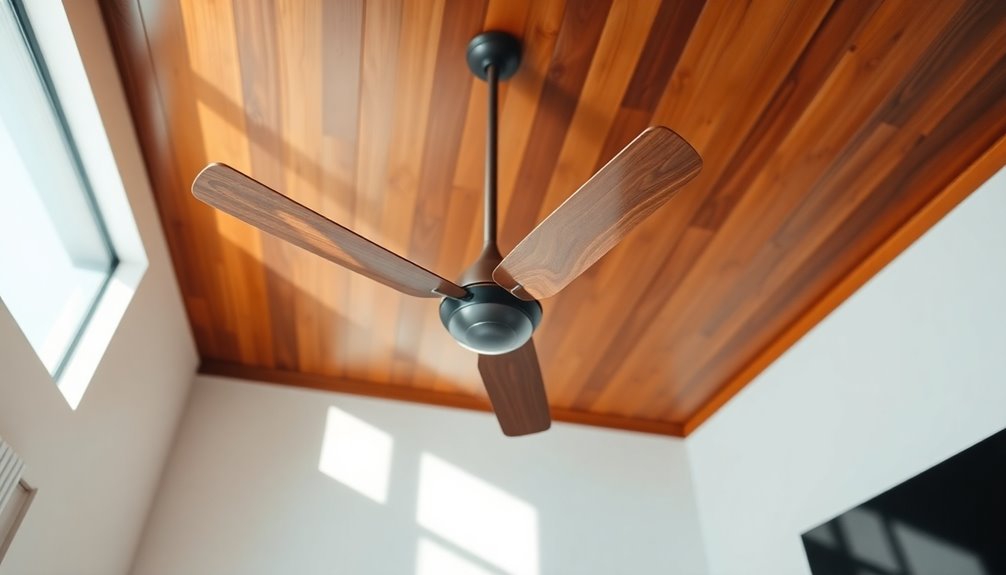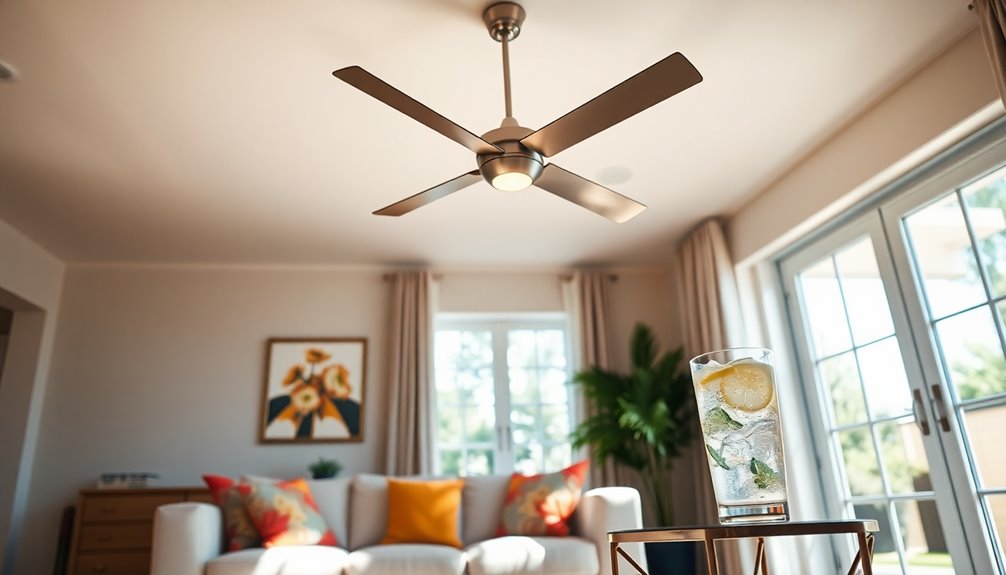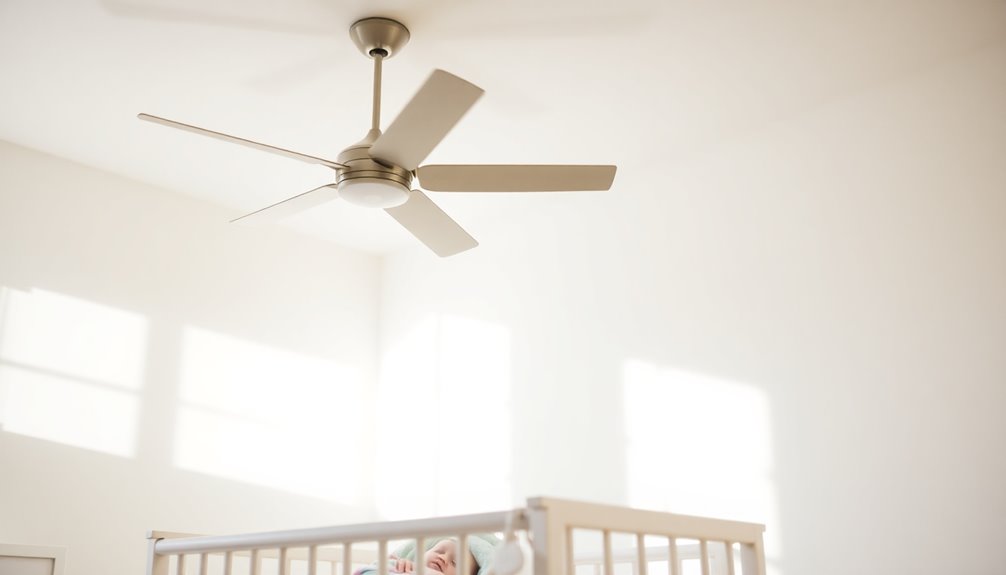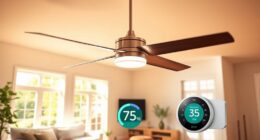Your ceiling fan should spin counterclockwise in summer to create a cooling downdraft, helping you feel more comfortable while potentially lowering energy costs. In winter, switch it to clockwise at a low speed to redistribute the warm air that collects near the ceiling. This adjustment can improve your home's heating efficiency as well. For the best results, make these changes as the seasons shift, like during Daylight Savings Time. Don't forget to keep your fan clean and check for any maintenance needs. There's plenty more to explore about optimizing your fan's performance and comfort.
Key Takeaways
- In summer, set the ceiling fan to rotate counterclockwise to create a cooling downdraft and enhance airflow.
- In winter, switch the fan to clockwise at low speed to circulate warm air and improve heating efficiency.
- Adjust fan direction during Daylight Savings Time changes: counterclockwise for spring and clockwise for fall.
- Regular cleaning and maintenance ensure optimal performance and airflow, improving comfort and energy efficiency.
- Always turn off the fan before changing its direction to ensure safety during adjustments.
Importance of Fan Direction

Understanding the importance of fan direction can greatly enhance your comfort at home. The direction of your ceiling fan plays a vital role in regulating room temperature.
During summer, setting your fan to rotate counterclockwise creates a rejuvenating downdraft that pushes cool air down, helping you feel cooler without cranking up the AC. In contrast, switching the fan to a clockwise rotation in winter allows it to circulate warm air trapped near the ceiling, increasing comfort levels while reducing energy costs.
When you adjust the fan direction according to the season, you can save notably on energy bills—up to 30% on cooling costs in summer and more than 15% on heating costs in winter. If your fan's direction is incorrect, you might experience inadequate airflow, leading to discomfort and higher energy bills due to inefficient heating or cooling.
Using the reverse option on your ceiling fan helps prevent overworking your heating systems in winter, promoting a more efficient use of energy resources. Additionally, modern Energy Star certified fans are designed for increased fan efficiency, which can lead to lower energy bills while enhancing airflow in your living space.
Seasonal Direction Guidelines

As the seasons change, adjusting your ceiling fan's direction becomes essential for maintaining comfort and energy efficiency.
Understanding seasonal adjustments can greatly enhance your indoor climate and save on energy bills.
- Proper ceiling fan direction can improve room temperatures.
- In summer, set your fan to turn counterclockwise to create a downdraft for cooling.
- During winter, turn clockwise at a low speed to create an updraft, redistributing warm air.
These adjustments can lead to energy savings of up to 30% in summer and 15% or more in winter.
An optimal time for changing the ceiling fan direction is during Daylight Savings Time adjustments.
Changing Fan Direction

Adjusting your ceiling fan's direction is straightforward and can greatly improve your comfort throughout the year.
To change the direction, always turn off the fan and let it come to a complete stop. For pull chain fans, locate the ceiling fan switch on the fan body to toggle the direction. You can spin the blades counterclockwise for summer, creating a cool breeze and enhancing air movement.
In winter, switch it to spin clockwise on high speed to circulate warm air.
If you've got a remote-controlled fan, turn off the fan first, then press and hold the fan button on the remote. You'll know it's changing direction when the light blinks.
For smart fans, simply use the compatible app or voice commands via SIMPLEconnect® WiFi® technology to make your home more comfortable.
After changing the direction, turn the fan back on to confirm it operates in the desired direction. This will guarantee you experience the ideal wind chill effect, keeping your environment just right for the season.
Timing for Direction Change

When it comes to changing your ceiling fan's direction, timing is key.
A great opportunity to make this switch is during Daylight Savings Time adjustments—specifically when you spring forward or fall back.
Daylight Savings Time Adjustments
One great opportunity to change your ceiling fan's direction is during Daylight Savings Time adjustments. This timing makes it easy to remember when to switch settings for ideal comfort and energy savings.
- Spring forward? Set your fan direction to counterclockwise for summer!
- Fall back? Switch it to clockwise to help with heating in winter.
- Adjusting your fan direction boosts cooling and heating efficiency.
- The right fan size enhances airflow and comfort in any room.
- Regular adjustments promote energy savings throughout the year.
When you spring forward in the spring, you should set the fan direction to counterclockwise. This helps create a cooling effect, allowing you to keep cool without cranking up the air conditioning.
Conversely, when you fall back in the fall, switch the ceiling fan to rotate clockwise. This helps redistribute warm air, keeping your space cozy during cooler months.
Seasonal Change Recommendations
Changing your ceiling fan direction with the seasons can greatly enhance your comfort and energy efficiency. A perfect time to change your ceiling fan is during Daylight Savings Time adjustments, specifically when you spring forward or fall back.
When springing forward, switch the fan to counterclockwise for the cooling summer months. This creates an invigorating downdraft that helps you feel cooler and reduces your air conditioning costs.
Conversely, when you fall back in the fall, set the fan to rotate clockwise. This direction helps redistribute warm air that rises to the ceiling, keeping your space cozy during the winter.
By ensuring your fan size is appropriate for your room, you'll enhance its performance, making those seasonal direction changes even more effective.
Regularly changing the ceiling fan direction according to the season not only boosts energy efficiency but also considerably improves your comfort levels at home.
Ceiling Fan Direction by Room

When it comes to your living room, setting the fan to counterclockwise can create a revitalizing breeze for relaxation or entertainment.
In the bedroom, adjusting the fan to a low clockwise setting helps maintain a cozy atmosphere while you sleep.
Let's explore how these adjustments can enhance comfort in each space.
Living Room Settings
In a living room, the right ceiling fan direction can greatly enhance your comfort throughout the year.
During summer, set your ceiling fan to rotate counterclockwise to create a cooling downdraft that keeps the space invigorating and reduces your reliance on air conditioning.
In winter, switch it to clockwise at a low speed to push warm air down from the ceiling, guaranteeing an even temperature without drafts.
Here are some tips for maximizing ceiling fan use in your living room:
- Set the fan to counterclockwise year-round if you have a vaulted ceiling to prevent excessive wind chill.
- When entertaining, use the clockwise setting to gently distribute warm air without cooling your guests or their food too quickly.
- Confirm your ceiling fan is appropriately sized for your living room; larger spaces may need multiple fans for airflow efficiency.
- Regularly clean your fan blades to maintain peak performance and comfort.
- Consider the fan's speed settings to adjust airflow based on seasonal changes.
Bedroom Comfort Adjustments
Adjusting your ceiling fan direction in the bedroom can greatly enhance your comfort and energy efficiency.
During the summer, set your fan to rotate counterclockwise. This creates a cooling downdraft that improves airflow, allowing you to raise your thermostat settings and potentially save up to 30% on energy costs.
In winter, switch the fan to clockwise at a low speed to circulate warm air that rises to the ceiling, leading to heating cost reductions of 15% or more.
If your bedroom has vaulted ceilings, maintaining a counterclockwise position year-round helps minimize the wind chill effect while ensuring adequate airflow.
In cases where you work in your bedroom, a medium clockwise setting can provide comfort without blowing papers around, making it a practical choice.
For those with smokers in the household, using a clockwise setting can draw smoke upwards, improving air quality and overall bedroom comfort.
General Ceiling Fan Tips

Ceiling fans can be a great addition to any indoor space, but using them correctly enhances their efficiency and lifespan. Here are some essential tips to keep in mind:
- Always clean the blades and motor regularly to prevent dust buildup.
- Remember to turn off the fan when you leave the room; it doesn't lower the temperature.
- If you feel little to no air movement, check for a failing motor or improperly pitched blades.
- Consider installing a remote control for easy operation and quick direction changes.
- Avoid using indoor ceiling fans outdoors, as they're not designed for those conditions.
In summer, set your ceiling fan to rotate counterclockwise to create a cooling breeze. This direction helps circulate cool air effectively.
In winter, switch it to clockwise to push warm air down from the ceiling. Regularly changing the fan direction according to the season is vital for best air circulation.
Finally, keeping the blades clean contributes to better airflow and energy efficiency, giving you control over your room's comfort.
Following these tips guarantees your ceiling fan operates smoothly for years to come.
Enhancing Comfort and Efficiency

Using your ceiling fan effectively not only improves airflow but also boosts comfort and energy efficiency in your home.
During the summer months, set your ceiling fan direction to rotate counterclockwise. This will make you feel up to 4 degrees cooler as the fan spins, creating a rejuvenating downdraft of cool air that helps keep your space comfortable. This simple adjustment can also reduce your energy costs by up to 30%, making it a smart choice.
When winter arrives, change your ceiling fan to rotate clockwise at a low speed. This helps push warm air down from the ceiling, maintaining a cozy atmosphere without overworking your heating system. By doing this, you can enjoy utility bill reductions of 15% or more.
To maximize energy efficiency year-round, verify your fan blades have a minimum angle of 12 degrees. This optimizes airflow, enhancing the cooling effect in summer and efficiently distributing warm air in winter.
Regularly changing your ceiling fan direction according to the season not only enhances comfort but also considerably reduces reliance on heating and cooling systems, making your home more energy-efficient overall.
Frequently Asked Questions
How Can You Tell if a Fan Is Going Clockwise or Counterclockwise?
To tell if a fan's going clockwise or counterclockwise, stand directly beneath it.
If the blades move from the top left to the bottom right, it's rotating clockwise. For counterclockwise, the movement should be from the top right to the bottom left, creating a cooling downdraft.
You can also feel the airflow; a breeze indicates counterclockwise, while still air suggests clockwise.
Use lightweight paper or a feather to confirm airflow direction, too!
What Is the Correct Way for a Ceiling Fan in the Summer?
Did you know running your ceiling fan correctly can cut energy costs by up to 30%?
In the summer, you want your fan to create a cooling effect, so make sure it spins counterclockwise. This direction pushes cool air down, enhancing your comfort and allowing you to raise your thermostat by about 4 degrees without feeling any difference.
Just stand underneath it and feel that invigorating breeze to confirm it's working right!
Which Way Should a Ceiling Fan Turn in Summer Reddit?
When you're using a ceiling fan in summer, it's crucial to make sure it's spinning the right way.
You'll want it to turn counterclockwise to create a cooling downdraft. This direction makes the air feel cooler, enhancing your comfort and allowing you to raise your thermostat a bit.
If you're unsure, just stand under it and feel for the breeze. Adjusting it can really help with energy costs, too!
Which Way Should the Switch Be on the Ceiling Fan?
To adjust the switch on your ceiling fan, make certain it's set correctly for the season.
In summer, you'll want it to spin counterclockwise to create a cool downdraft.
In winter, flip the switch to clockwise to push warm air down from the ceiling.
Always turn off the fan before changing the direction, and check the blade movement afterward to verify it's set properly for your comfort.
Conclusion
In the dance of air, ceiling fans can be your best partner, swirling cool breezes in summer and cozy warmth in winter. By steering them in the right direction, you'll not only keep your space comfortable but also save on energy bills. So, don't let your fan sit idle; give it a gentle nudge and watch it work its magic. Embrace the rhythm of the seasons, and let your ceiling fan be the maestro of your home's comfort.









